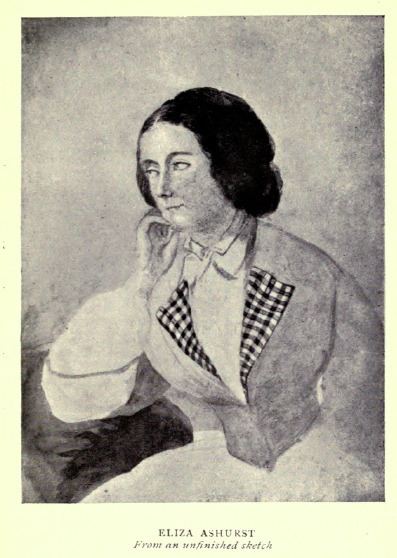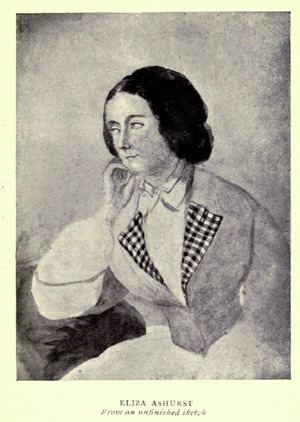Name Elizabeth Ashurst | Parents William Henry Ashurst | |
 | ||
Elizabeth "Eliza" Ann Ashurst Bardonneau (8 July 1813 – 25 November 1850) was a member of an important family of radical activists in mid-nineteenth-century England and the first translator of George Sand's work into English. The family supported causes ranging from women's suffrage to Italian unification.
Contents

Early life
On 8 July 1813, Elizabeth Ashurst was born to Elizabeth Ann Brown and William Ashurst. She was the oldest child. Her siblings were William Henry Ashurst Jr., Caroline Ashurst (Stansfeld), Emilie Ashurst (Venturi) and Matilda Ashurst (Biggs). She grew up in the Ashurst home in Muswell Hill, London.
George Sand translations
Ashurst and Giuseppie Mazzini exchanged correspondence starting in 1844. In one transmission she sent him a translation of Spiridion by George Sand. Mazzini responded that he liked it and suggested that she also translate a work of Sand's he admired, Letter of a Traveller.
At a period in time when George Sand's free-love and independent lifestyle was quite unusual for a 19th-century woman, Elizabeth Ashurst and Matilda Hays were "broad-minded" and intrigued by the political and social messages addressed in Sand's books. Hays had received support and encouragement from William Charles Macready and George Henry Lewes to translate Sand's novels into English. Both wrote to Sand encouraging the arrangement and a friend of Hays, chaplain Edmund Larken provided funding for the enterprise.
The initial translations of Sand's works were done by Hays, Ashurst, and Larken. La Derniere Aldini, the first volume, was translated by Hays. Ashurst translated Les Maitres mosaistes and it was published in 1844. Mazzini wrote a preface for Ashurt's translation of Lettres d'un voyageur. Sand, at Mazzini's urging, invited Ashurt to her home in Nohant. Olive Class reported that "Sand was unsettled by the superficial display of feminist rebellion exhibited by her as yet still unmarried disciple and characterized her as 'a prude without modesty.'"
George Henry Lewes suggested to Hays that the translation to the English language toned down some of the rhetoric with an English cultural sensibility. Mazzini, aware of Lewes suggestion to Hays, wrote to Sand, referring to Hays: "My friends and I consider it unthinkable that you would be willing to give such license to someone whose ideas are unknown to you."
Four volumes of Sand's work were translated by Hays and Amhert and published, but they floundered. In attempting to tone down Sand's ideas, the translated books were "stripped it of its power," according to Giuseppe Mazzini, an Italian revolutionary and friend of George Sand. The translations were "a smuggler's attempt to conceal the real nature of his infamous cargo," reported the Quarterly Review".
Both Hays and Ashurst also has poor financial rewards, due to the arrangement that they had made with a "bad business publisher." They worked to find publishers for their translated and edited versions of Sands' work. Larken's work with Hays and Ashurst came to an end in 1847.
Published translations
Ashurst translated the following books:
Personal life
She was a dear friend to the Italian nationalist Giuseppe Mazzini until her early death. Mazzini and the Ashurst family grew close, and Mazzini considered himself part of the Ashurst family, calling the Ashurst daughters "sister". Eliza, though, may have wished to have been more than a loving sister. His letters to her are reprinted in E. F. Richards' collection: Mazzini's Letters to an English Family.
In 1840 she, her sister Matilda and her father attended the World Anti-Slavery Convention in London although she would not have been permitted to speak as the women were not regarded as full delegates.
She met a French artist in Paris in 1847 or 1848, fell in love and married Jean Bardonneau, Esquire (Also known as Bardonneau–Narcy), against the wishes of Mazzini and her family. While living in Paris, she miscarried and later died in childbirth on 25 November 1850.
It was Mazzini who relayed the sad news to her sisters Emilie Ashurst Hawkes (later Venturi) and Matilda Ashurst Biggs, who were in Genoa at the time. Her brother William Henry Ashurst, Jr. and sister Caroline were en route to Paris to attend to her, but Elizabeth died before they made it to Paris. While in Paris they were very unhappy about the burial and burial place for their sister. They later had her body sent back to England for burial in the Highgate Cemetery, where they had a family vault.
Her premature death cut short a life devoted to radical causes.
